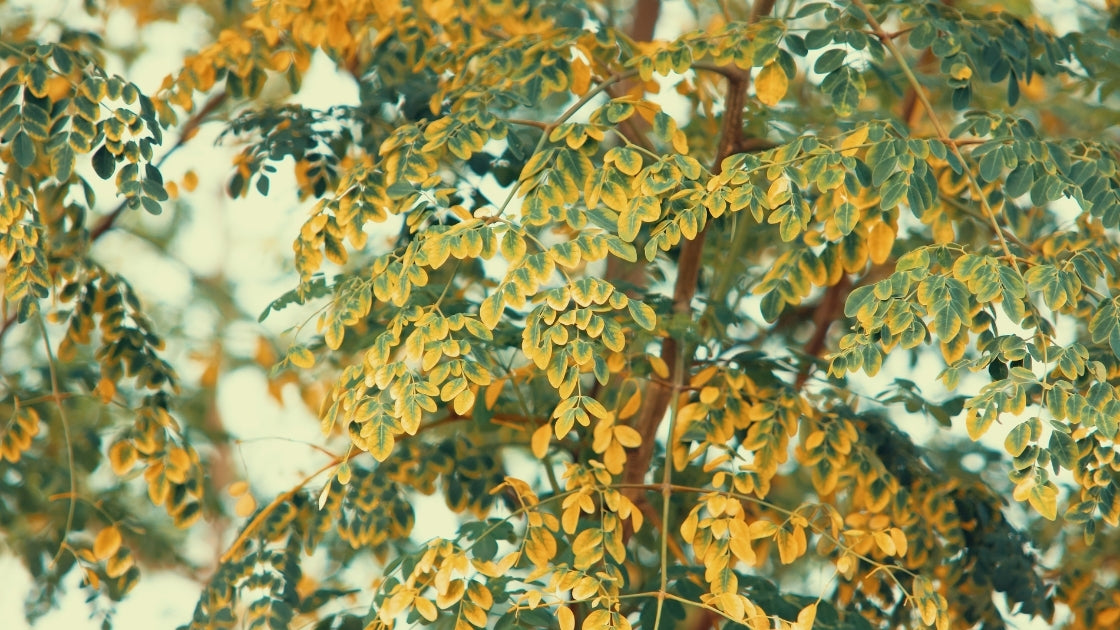Moringa Oleifera – A Magical Superfood

This plant is commonly known as ‘moringa’ or ‘drumstick tree’ because of its long and triangular seedpods. It is also known as horseradish tree or benzolive tree. This plant is mainly grown in South Asia and Southeast Asia. It is said to be originated from northern India and later it was introduced to other countries like Bangladesh, Sri Lanka, Africa and America.
Moringa Oleifera is dry in nature, it does not need extensive cultivation technique. It is best grown in sun and suitable for dry regions. When fully grown, it can stretch to a height of 10-12 meters. This is a deciduous, drought-resistant and fast-growing plant mainly cultivated in tropical and sub-tropical regions. It is easily available in local markets in Northwestern India. It is a popular vegetable dish and commonly used in popular ‘sambar’ recipe in South India.
Vernacular name of this plant is Shigru (moves like an arrow) which is a Sanskrit term. The horseradish tree has different names for different parts of India like sahijan or munaga in hindi, shajina in bengali, sohanjana in punjabi, saragavo or sekato in gujarati, sujuna in oriya, sajiwan in nepali, ma rum in thai and kelor in Indonesian.
Moringa is a genus name derived from the malayalam word ‘Muringo’ which means ‘twisted pod’. And the word ‘oleifera’ is taken from latin word ‘oleum’ meaning oil and ‘ferre’ meaning ‘to bear’. This is the main genus from Moringaceae family. This plant is mainly grown for its leaves, nutritious pods, flowers and seeds for their high nutritional value. Specifically, moringa leaves, which are high in vitamins, minerals and amino acids. The leaves can be eaten as fresh or cooked. The dried powder made from the dried leaves can be stored for months without refrigeration and without losing any nutritional value.
Fresh moringa leaves (100 grams) contain 2500 picograms of Vitamin A which is 10 times more than a cup of chopped carrots. The leaves are a great source of carotenoids as well. Vitamin A is important in the growth of immune cells, embryo and clarity in vision. Around 200mg of Vitamin C is present in 100 grams of moringa leaves which is 7 times more than what is found in oranges, which is highly effective in reduction of free radicals and toxins due to its high antioxidant properties. Along with that, moringa leaves come with fully packed vitamin B group – thiamine (B1), riboflavin (B2), niacin (B3), pantothenic acid (B5), vitamin B6 and folate (B9). Moringa leaves are high in flavonoids which is known to heal microbial infections, cardiovascular disease, stress, high cholesterol, fever, inflammation, diabetes and cancer.
Surprisingly, this simple looking plant is a great source of calcium (about 2500 mg of calcium is present in 100 gm of dried leaves) which is 17 times more than milk and iron (40 mg in 100gm) which is 25 times more than spinach. It contains 337 mg of potassium which is 15 times more than bananas. It also contains Vitamin E and other minerals like manganese, sodium, phosphorus and Zinc in moderate quantities. In addition to that, moringa leaves are the powerhouse of amino acids which is not produced in human body. As per one study, almost about 70% of the leaf is packed with protein and 28% of the leaf contained total 17 amino acids. Amino acids help in building and repairing the muscle tissues and essential in synthesizing protein.
This plant is also extremely wonderful detoxifier (due to its sharp and piercing quality) as it penetrates the tissues as deeply as bone marrow for deep and rapid cleansing. As per another research, extracts from moringa leaves have shown to stop the growth of cancer cells. The active bio-compounds present in the leaves like niazimicin, beta-sitosterol, beta-carotene, benzyl isothiocyanate and glucopyranoside have anti-cancerous effects in fighting the cancerous cells and DNA damage. In fact, there are several studies having found that the bioactive components of the leaves can actively prevent heart disease, non-alcoholic fatty liver disease (NAFLD), Alzheimer’s, Parkinson’s disease and hypertension.
All parts of this drumstick tree (root, gum, bark, leaf, flower, fruit, sap, seed and seed oil) are used as juice, decoction and power as traditional medicine to treat various ailments like skin problems, anaemia, gout, diarrhoea, gastric ulcer, thyroid, headache, bronchitis, asthma, diabetes, joint pain, rheumatism, cholera and hysteria and many other chronic diseases like hepatic fibrosis and cancer. No wonder it is known as ‘Miracle tree’ because of its impressive nutritional and medicinal values.
Ayurvedic properties of Moringa tree as per Dravyaguna Vijnana –
Rasa: Katu (pungent) and Tikta (bitter)
Guna: Laghu (light), Ruksha (dry) and Tikshna (Sharp)
Virya: Ushna (heating)
Moringa is useful to balance vata and kapha when used in moderate amount. As it is light, dry and sharp in nature, excess usage can increase vata dosha and pitta dosha. One can consume moringa dry leaves powder with a glass of warm milk and little bit of honey to pacify vata or can be taken with a spoon of aloe vera to cool down its heating effect.
Moringa leaves are used to increase milk production in lactating mothers for the child’s nourishment. This is the reason, in Philippines, moringa leaves are often referred as ‘Mother’s best friend’. Since 1998, World Health Organization (WHO) is promoting moringa leaves as alternative food supply to fight malnutrition in poor countries.
Moringa Oleifera is one of the 20,000 crucial medicinal plants recorded by ancient ayurvedic authors (Sushruta and Vagbhata) which has all its parts (from roots to the leaves) used for its nutritional as well as medicinal healing and preventive properties. That is why this plant is rightly referred to as ‘gift of nature’ for its multipurpose benefits. No wonder it’s a superfood in ordinary attire.
Published By: Ayurveda Store New Zealand | All Rights Reserved.
References:
https://www.ncbi.nlm.nih.gov/pmc/articles/PMC5745501/
https://www.journalijdr.com/sites/default/files/issue-pdf/10888.pdf







